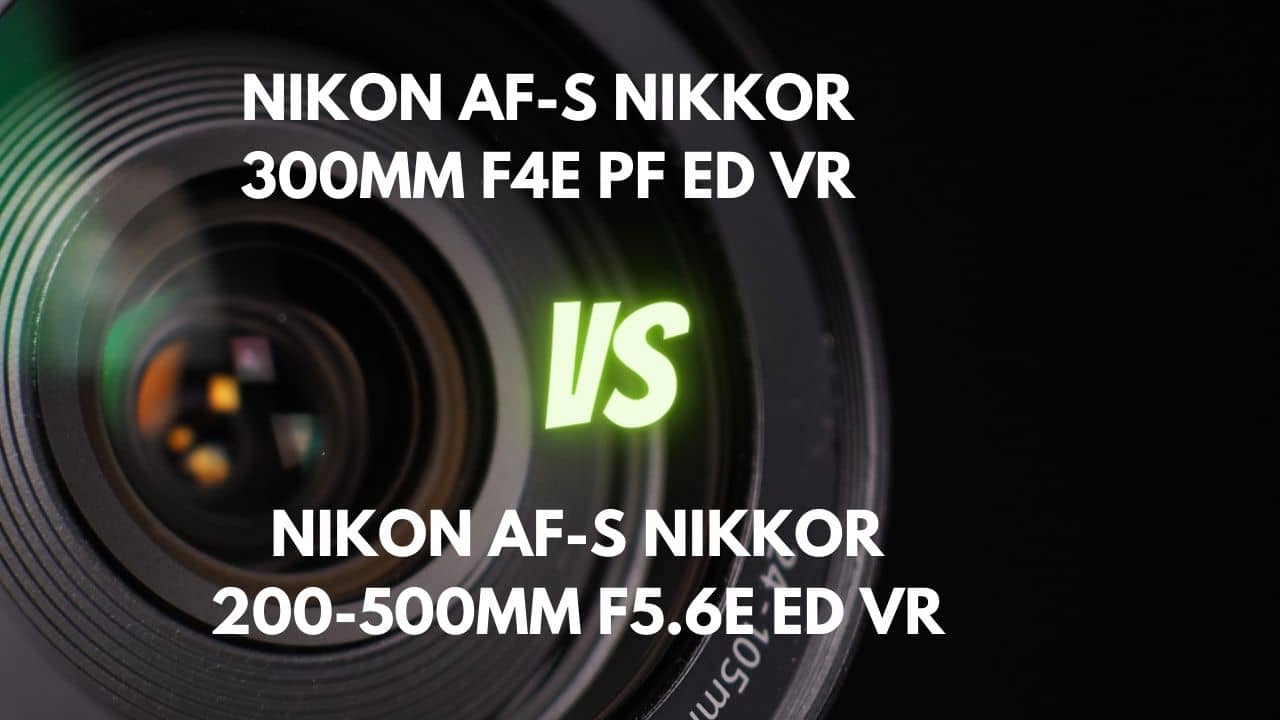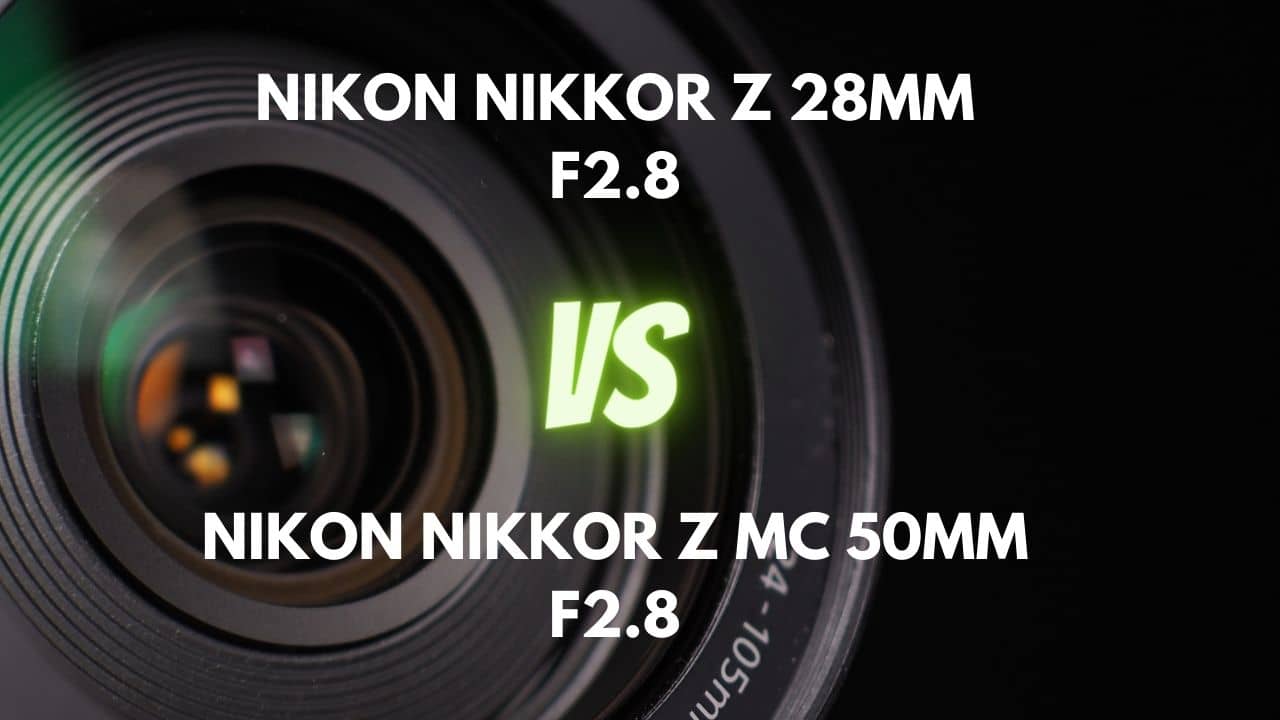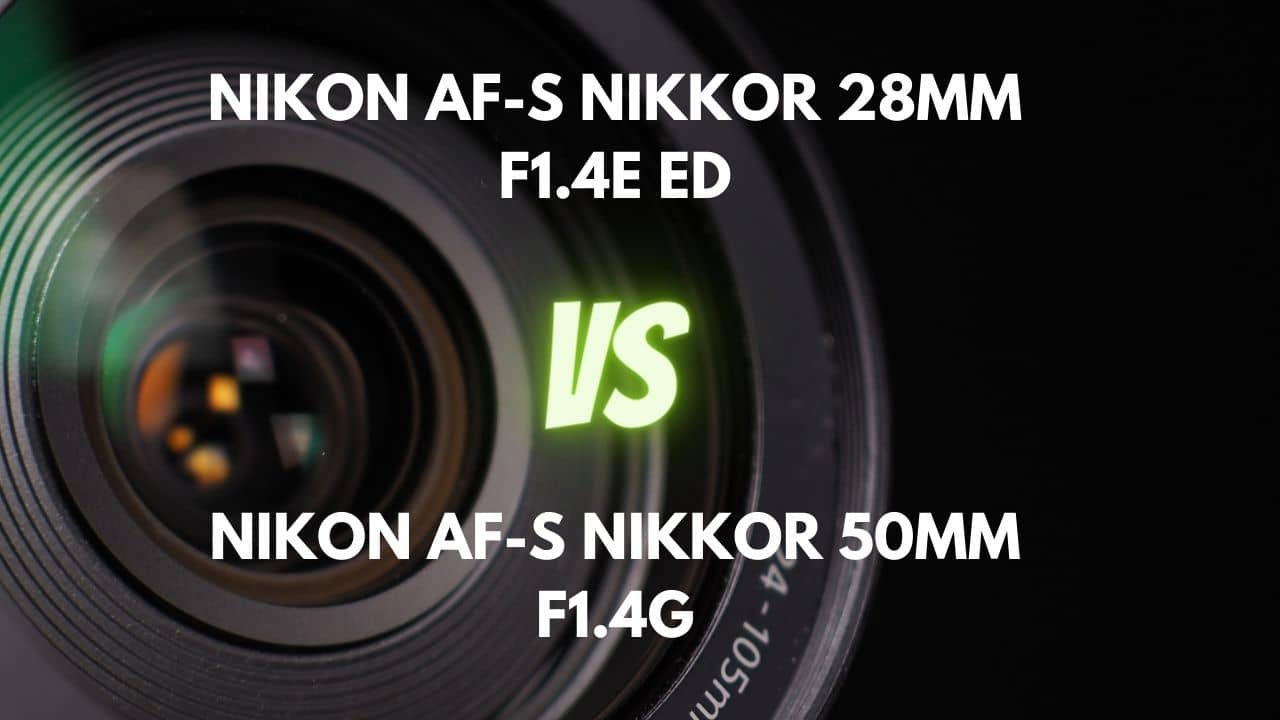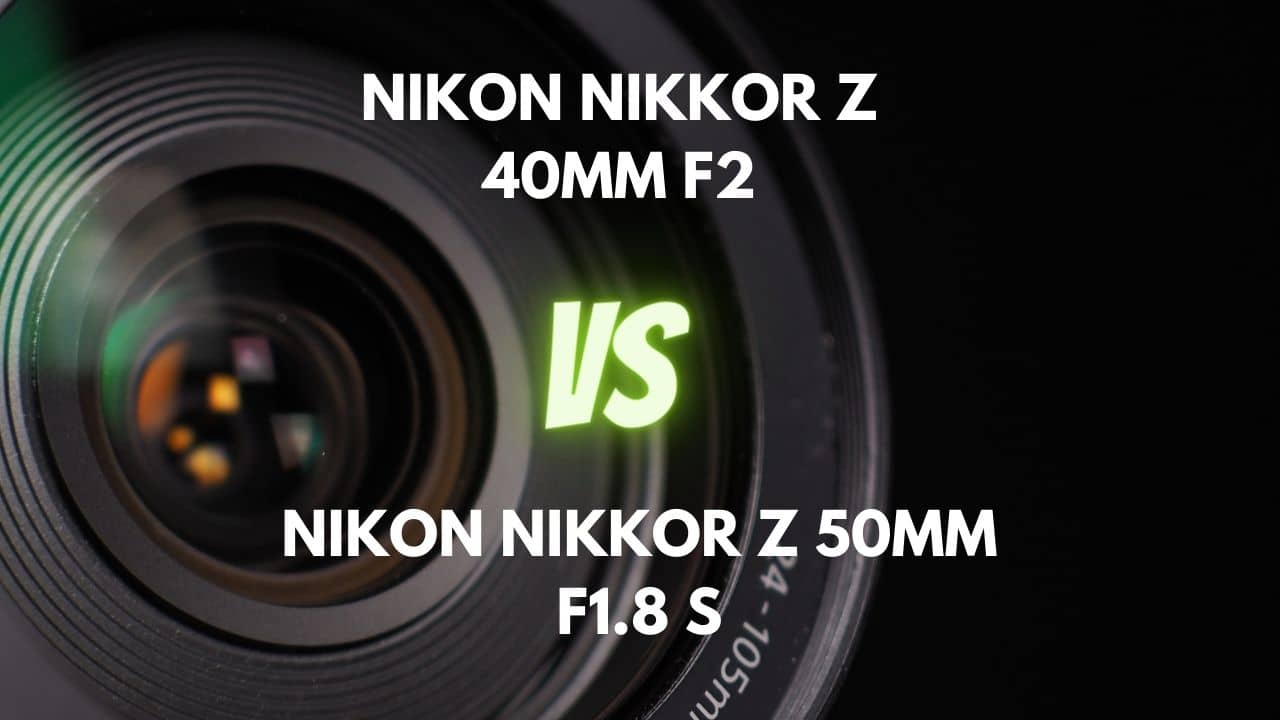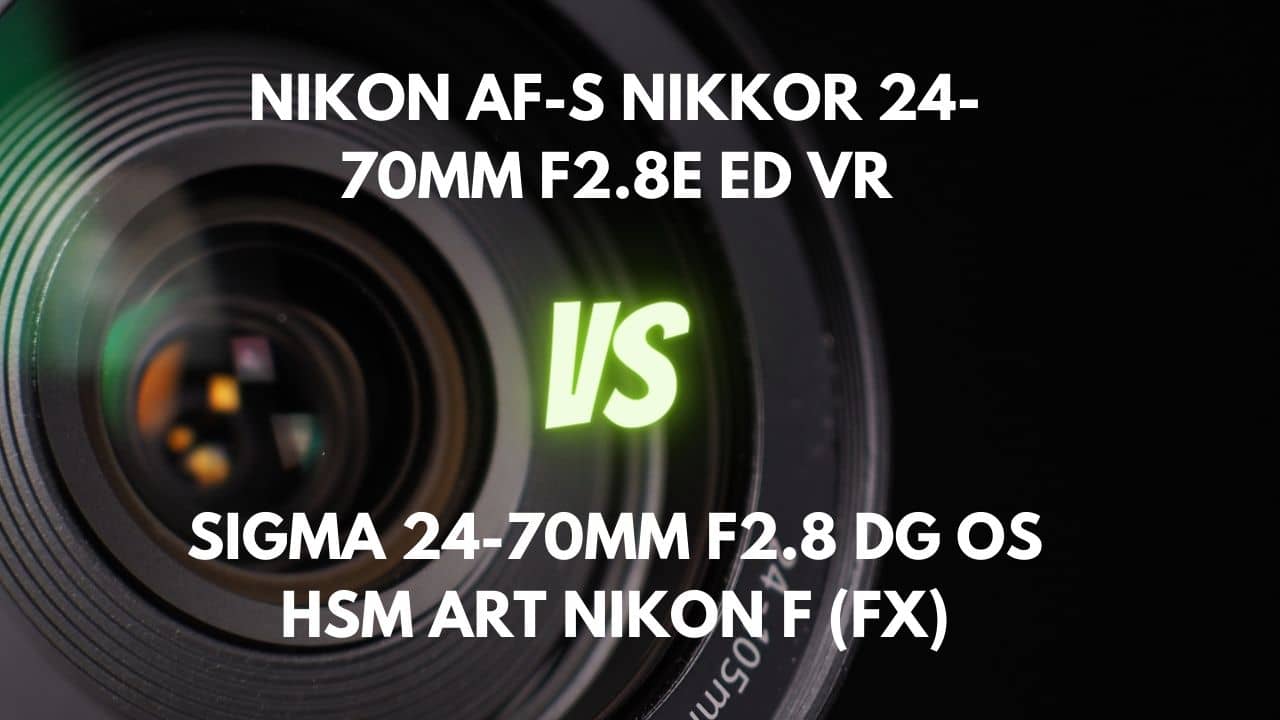If you’re a photography enthusiast who’s passionate about capturing the world through a lens, you’ll understand the significance of having the right gear. Picking the perfect lens for your camera is like choosing the best paintbrush for an artist—it can genuinely transform the way you create. Today, we’ll be delving deep into a detailed comparison of two noteworthy contenders in the photography world: the versatile Nikon 28-300mm f/3.5-5.6 and the dynamic Nikon 70-200mm f/2.8.
Why these two, you ask? Well, they each cater to different photographic styles and skill levels, thus providing a broad spectrum for comparison. The 28-300mm lens, with its wide-ranging focal length, is a ‘jack-of-all-trades’, excellent for those stepping into the world of photography or seasoned photographers who appreciate the convenience of a single lens solution. On the other hand, the 70-200mm lens, often touted as a professional’s companion, excels in producing stellar image quality and is a favourite among portrait, event, and sports photographers.
But the real question here is, which one would better suit your unique style and shooting requirements? This comprehensive comparison will serve as your guide, navigating you through the details and intricacies of these two lenses. We’ll cover everything from image quality, distortion, bokeh effect, to focusing performance and more.
By examining these lenses in detail, you’ll gain an understanding of the key factors to consider when investing in a lens, equipping you with the knowledge to make an informed decision. So, whether you’re an eager beginner, a passionate intermediate, or a professional photographer, this guide promises to add value and insights into your photographic journey.
Hold onto your camera straps, folks. It’s time to dive into the fascinating world of lens comparison.
Let the exploration begin!
Overview
| Nikon AF-S NIKKOR 28-300mm F3.5-5.6G ED VR | Nikon AF-S NIKKOR 70-200mm F2.8E FL ED VR | |
|---|---|---|
| Max Aperture | F3.5-5.6 | F2.8 |
| Aperture Type | Variable | Fixed |
| Focal Range (mm) | 28-300 | 70-200 |
| Mount Type | Nikon F (FX) | Nikon F (FX) |
| Max Format | 35mm FF | 35mm FF |
| Zoom Ratio (X) | 10.7 | 2.9 |
The Nikon 28-300mm f/3.5-5.6 and the Nikon 70-200mm f/2.8 are both designed to fit Nikon F (FX) mount type and are compatible with 35mm Full Frame format, but they present key differences in terms of aperture, focal range, and aperture type that might impact your choice depending on your photography needs.
The 28-300mm lens has a variable aperture of f/3.5-5.6, which means the maximum aperture changes across the focal length range. At 28mm, the maximum aperture is f/3.5, but it narrows to f/5.6 at 300mm. Variable aperture lenses like this one are typically more affordable and lighter, which can be an advantage for those who prioritize budget and portability. However, this lens might struggle in low light situations, especially at the telephoto end, due to the smaller maximum aperture. Despite these potential drawbacks, the broad focal range of this lens offers a great deal of versatility, making it suitable for a wide variety of photographic genres, from wide-angle shots (at 28mm) to telephoto shots (at 300mm).
On the other hand, the 70-200mm lens has a fixed aperture of f/2.8, which means it maintains the same maximum aperture throughout the entire zoom range. Fixed aperture lenses, such as this one, usually offer better performance in low-light conditions and more consistent image quality across the entire zoom range due to the larger maximum aperture. However, they tend to be heavier and more expensive. In terms of focal range, the 70-200mm lens is strictly a telephoto lens. This makes it ideal for applications like sports, wildlife, and portrait photography where a shallow depth of field for subject isolation is often desired.
To sum up, if you value versatility, wide-angle to telephoto coverage, and a lighter, more affordable lens, the 28-300mm lens would be a solid choice. However, if your priority lies in low light performance, a consistent maximum aperture, enhanced image quality, and subject isolation due to a shallow depth of field, and you don’t mind the extra weight and cost, the 70-200mm lens would be the superior option.
Design and Ease of Use
| Nikon AF-S NIKKOR 28-300mm F3.5-5.6G ED VR | Nikon AF-S NIKKOR 70-200mm F2.8E FL ED VR | |
|---|---|---|
| Diameter x Length (mm) | ⌀83×114.5mm | ⌀88.5×202.5mm |
| Weight (gr) | 800 | 1430 |
| Filter Thread (mm) | 77 | 77 |
| Weather Sealing | No | Yes |
| Zoom Method | Rotary (extending) | Rotary (internal) |
| Distance Scale | Yes | Yes |
| DoF Scale | No | No |
| Hood Supplied | Yes | Yes |
| Hood Code | HB-50 | HB-78 |
The Nikon 28-300mm f/3.5-5.6 and Nikon 70-200mm f/2.8 showcase differing characteristics when it comes to physical specifications such as size, weight, and zoom method, each offering its unique advantages and trade-offs.
The 28-300mm lens has a diameter and length of 83mm and 114.5mm respectively, and weighs 800g. These measurements reveal that this lens is comparatively more compact and lightweight than the 70-200mm lens, making it potentially easier to carry around and less tiring during extended shooting sessions. This could be particularly advantageous for those involved in travel photography or on-the-go shooting scenarios.
However, this lens employs a rotary extending zoom method, which means it extends in length when you zoom in. While the extending design contributes to its relatively simpler structure and lighter weight, it might affect the overall balance of your camera setup as you zoom, and could make the lens more susceptible to elements like dust and moisture due to difficulties in weather sealing.
In contrast, the 70-200mm lens, with its diameter and length measuring 88.5mm and 202.5mm respectively, is visibly larger, and at 1430g, nearly double the weight of the 28-300mm lens. This larger size and weight could pose challenges for portability and handling, especially for extended periods. It might also draw more attention in situations where discretion is preferred, such as street photography.
However, this lens employs a rotary internal zoom method. This means it maintains its size regardless of zoom adjustments, leading to a consistent camera balance, potentially making it easier to handle during shooting. It also generally allows for better weather sealing, protecting the lens from dust and moisture. However, this internal zoom mechanism can contribute to the overall weight and complexity of the lens, potentially affecting its cost and durability.
In conclusion, choosing between the 28-300mm and 70-200mm lens depends on what you value most in a lens. If portability and simplicity are your top priorities, the 28-300mm lens would be a fitting choice. However, if you’re willing to trade off some weight for a consistent size, better weather sealing, and a balanced feel during zooming, then the 70-200mm lens could be considered superior.
Lens Mount and Barrel
Beginning with the Nikon 28-300mm f/3.5-5.6, its lens mount showcases a durable construction made of solid metal featuring a dull-chromed brass finish. This lends the lens an air of professionalism and enhances its longevity. The rubber seal surrounding the mount adds a layer of basic protection against dust, underlining the thoughtfulness behind its design.
However, the lens barrel of the 28-300mm lens, made primarily of plastic with a rubber-coated zoom ring, offers an appreciable lightweight feel. Its design facilitates easy handling, contributing to portability. While plastic might not be as enduring as metal, it’s a more cost-effective choice, making this lens an appealing option for those with budget considerations. Notably, the 28-300mm lens experiences a significant extension while zooming, which can affect the balance of your camera setup but also enables a broad zoom range.
In contrast, the Nikon 70-200mm f/2.8 presents a metal lens mount, like its counterpart, further fortified with a rubber gasket. This feature enhances the lens’s resilience against dust and moisture ingress, reinforcing the lens’s robustness. Moreover, this lens is compatible with Z series mirrorless cameras via an FTZ adapter due to its F-mount designation, widening its utility.
When it comes to the lens barrel, it combines magnesium alloy and plastic elements. This amalgamation ensures the lens is both lightweight and sturdy. The strategic usage of metal enhances its durability and provides a professional feel without significantly adding to the lens’s weight.
In summation, the 28-300mm lens, with its lightweight construction and broad zoom range, would be an excellent fit for photographers seeking portability and cost-effectiveness. On the other hand, the 70-200mm lens, with its superior resistance against dust and moisture along with the balanced construction of its lens barrel, would appeal to those prioritizing durability and a professional feel.
Weather Sealing
The Nikon 28-300mm f/3.5-5.6 and 70-200mm lenses show distinct contrasts concerning their weather sealing, which plays a vital role in safeguarding a lens against harsh environmental conditions, increasing its durability and operational efficiency in diverse settings.
Firstly, the 28-300mm lens, while not explicitly defined as weatherproof, includes a basic rubber seal around the lens mount that acts as a defense against dust. This minimalistic sealing approach, however, leaves the lens susceptible to potential damage when used in challenging environments.
Crucially, it lacks internal seals at the rings, switches, and front of the barrel, and there’s no protective fluorine coating on the front element. This lens would thus require extra care when shooting in unpredictable or inclement conditions, which might be a significant factor for outdoor photographers to consider.
In contrast, the Nikon 70-200mm f/2.8 has made extensive weather sealing provisions. A rubber grommet at the lens mount and a rubberized front end enhance the lens’s resilience, acting as barriers against environmental elements when the lens cap is attached. Its weather sealing extends beyond just the critical points, encapsulating every movable part of the lens barrel. The construction involves a diverse mix of materials including gaskets, rubber, metal, and plastic, contributing to a robust protection system.
Furthermore, the front and back elements are fortified with fluorine coatings that ward off dirt, water droplets, grease, fingerprints, and smudges. This ensures optimal performance even in harsh conditions, making this lens a reliable choice for those often shooting outdoors or in challenging weather.
In conclusion, when it comes to weather sealing, the 70-200mm lens surpasses its counterpart. Its comprehensive sealing strategy ensures its resilience and reliable performance across a broad spectrum of conditions. However, it’s crucial to remember that the need for weather sealing depends on your specific shooting scenarios. While the 70-200mm lens offers superior weather resistance, the 28-300mm lens might be perfectly adequate if you usually operate in controlled, less-demanding environments.
Rings
The Nikon 28-300mm f/3.5-5.6 and 70-200mm lenses both feature two distinct rings – a zoom ring and a focus ring – which enable photographers to adjust zoom and focus with precision. However, their design, location, and functionality differ, which may affect a user’s experience and preference.
The 28-300mm lens positions the zoom ring towards the front, with the focus ring closer to the lens mount. The zoom ring is an inch wide, surfaced with raised ribs and covered in a tactile rubber for an enhanced grip. This design allows two fingers to comfortably navigate its 90-degree turning radius, offering intuitive control. The focus ring is more slender, made of a grippy plastic. It lacks a depth-of-field indicator, though there’s a distance scale housed behind a protective window. The lens also features a beneficial zoom lock switch at the 28mm position to prevent unintended zoom adjustments, known as zoom creep.
Comparatively, the Nikon 70-200mm f/2.8 also situates the zoom ring at the front, with the focus ring towards the back. The zoom ring smoothly operates through a 90-degree turn, though it’s described as grinding against the lens housing, potentially hindering the user experience. The raised part on the zoom ring assists with grip, and the focus ring transitions from close focus to infinity within half a turn. Unfortunately, the focus indicator lacks any depth-of-field markers, though markings in feet and meters are present. Notably, the positioning of the rings is reversed from previous models, a change that may take some adjustment for seasoned Nikon users.
Ultimately, between the two, the 28-300mm lens has the upper hand when it comes to the ring design. Its broader, rubber-covered zoom ring provides superior ergonomics and control. Meanwhile, the 70-200mm lens, despite offering quick focus adjustments, might present challenges with its potentially less-comfortable rings and reversed design. Of course, the choice between these two would largely depend on individual shooting style, preference, and adaptability.
Switches/Buttons
The Nikon 28-300mm f/3.5-5.6 and the 70-200mm lens both offer a set of switches/buttons on their barrels that contribute to the overall usability and functionality. However, their count, function, and user-friendliness significantly differ.
The 28-300mm lens maintains simplicity with three switches. One switch allows for easy toggling between manual and autofocus modes, another provides control over the Vibration Reduction system, and the third switch enables selection between active and normal modes. The lens prioritizes easy navigation, making these switches conveniently identifiable and straightforward to operate, ensuring a user-friendly experience.
On the other hand, the Nikon 70-200mm f/2.8 boasts an array of switches and buttons, catering to photographers seeking more advanced features. It includes an AF/MF switch with three settings: A/M (autofocus priority), M/A (manual priority), and M (manual), offering a range of control over focusing. There’s a focus limiter to confine the autofocus range if needed, and an IS switch to control the Vibration Reduction (VR) system with Normal, Sport, and Off modes. The standout feature is the presence of four customizable function buttons. These can be programmed through the camera’s menu or used in AF-L (autofocus lock), AF-On, or Off modes with any DSLR, providing valuable versatility for tracking subjects and locking autofocus.
While the 28-300mm lens prides itself on simplicity and easy usability, the 70-200mm lens offers superior control, versatility, and customization with its various switches and buttons. Thus, if the consideration is purely about the switches/buttons, the 70-200mm lens stands out as superior, particularly for those requiring or appreciating advanced controls and customization.
Filter Thread
The Nikon 28-300mm f/3.5-5.6 and the 70-200mm lens both feature a 77mm filter thread, which is a standard and popular size, thus providing compatibility with a wide range of available filters at a reasonable price. This size also offers a good balance between potential vignetting, image quality, and lens size and weight.
The 28-300mm lens comes with a non-rotating filter thread made of plastic. This feature, along with the thread not rotating on focus, simplifies the usage of filters like polarizing and neutral density ones, as their effect remains consistent throughout the focus range. The plastic material, though less durable than metal, offers the advantages of being lightweight and more resilient to impact, bouncing back more easily after a drop and thereby reducing the risk of cross-threading.
On the other hand, the Nikon 70-200mm f/2.8 boasts a metal filter thread, contributing to a more robust and durable construction that’s commonly found in pro-level lenses. This upgrade from plastic versions offers an assurance of longevity and reliability. The metallic thread allows for smooth mounting and dismounting of filters without worrying about cross-threading. It easily accommodates standard filters such as rotating polarizers and graduated filters.
Considering the above factors, if you prioritize durability and a professional-grade build, the 70-200mm lens with its metal filter thread is the superior choice. However, if your preference lies in the resilience and lightness of a plastic filter thread, the 28-300mm lens would be more suitable. Overall, the choice is largely dependent on the individual user’s preferences and photography needs.
Lens Hood
The Nikon 28-300mm f/3.5-5.6 comes equipped with a plastic bayonet HB-50 hood, having a petal shape intended to function optimally at the lens’s wider end. This design facilitates smooth rotation of the hood and pairs with a matte finish on the interior to help reduce internal reflections, ultimately mitigating unwanted flaring. The lens hood is included with the lens package, thereby enhancing the overall value of the lens.
In contrast, the Nikon 70-200mm f/2.8 features a plastic lens hood that’s flatter on top compared to its rounded predecessor. This new design makes quick lens changes easier. It fits tightly on the lens, ensuring a stable and secure attachment, reducing the risk of inadvertent detachment. Its inclusion in the lens package is important, given that a replacement could be costly. The lens hood’s primary function is to diminish ghosting and flare in images, especially during overhead sun photography, and it is recommended to be kept attached to the lens.
Neither of the lens hoods appears to feature exterior ribbing which could improve grip during attachment and removal. However, both hoods are durable and lightweight due to their plastic construction, providing effective protection against impacts, dust, and moisture.
In terms of the locking mechanisms, the 28-300mm lens uses a bayonet mount, which offers secure attachment and quick installation and removal, although it may take some practice for first-time users to align properly.
To conclude, both lens hoods serve their primary function of reducing flare and protecting the lens effectively. However, the 70-200mm lens’s hood, with its flat-top design allowing for quicker lens changes and tighter fit, edges out slightly. The final verdict would ultimately depend on your preference for either a petal-shaped design with smooth rotation (28-300mm lens) or a flatter design facilitating quicker lens changes (70-200mm lens).
Focusing and Optical Stabilization
| Nikon AF-S NIKKOR 28-300mm F3.5-5.6G ED VR | Nikon AF-S NIKKOR 70-200mm F2.8E FL ED VR | |
|---|---|---|
| Autofocus | Yes | Yes |
| AF Motor | Silent Wave Motor | Silent Wave Motor |
| Rotating Front Element | Does not rotate on focusing | Does not rotate on focusing |
| Min Focus Distance | 0.5m | 1.1m |
| Max Magnification (X) | 0.32 | 0.21 |
| Full-Time Manual Focus | Yes | Yes |
| Focus Method | Internal | Internal |
Focusing Performance
The Nikon 28-300mm f/3.5-5.6 exhibits a moderate focusing performance. While it manages to perform reasonably with stationary subjects, it may have difficulties keeping pace with fast-moving subjects like birds in flight, making it less suitable for action or sports photography. Its focusing speed is adequate but not lightning-fast, taking approximately a second to adjust from infinity to 0.5m. At longer focal lengths, it may hunt for focus, slightly slowing down the process. Although the autofocus motor is not completely silent, emitting a subtle high-pitched whine during operation, it’s generally discreet enough to avoid disturbing subjects. Consistent autofocus accuracy across various settings ensures sharp results under diverse conditions.
Its manual focus override and smooth focus ring allow for precise manual adjustments when necessary. The internally focusing design keeps the lens length constant, enhancing its handling ease. Some focus breathing is present at 300mm, but it doesn’t negatively affect the image quality. The lens’s performance may falter in low-light situations, though the vibration reduction system somewhat mitigates the impact of slower shutter speeds.
In contrast, the Nikon 70-200mm f/2.8 offers exceptionally swift and near-silent autofocus performance, even in low light, making it ideal for a variety of shooting conditions. It achieves high focus accuracy and repeatability, without any notable performance variations. The smooth-moving focus ring eliminates slack or play, providing an immediate response.
An advantageous manual focus override is included, and the lens can adjust focus from close to infinity in less than half a rotation. With a focus speed of about 0.35 seconds from infinity to 2m at 200mm focal length, the lens demonstrates remarkable speed. As a result, its overall autofocus performance is nothing short of impressive.
While both lenses have their strengths, the 70-200mm lens significantly outshines the 28-300mm lens in terms of focusing performance. Its speedy, ultra-quiet autofocus, precise manual focus override, and exceptional focus accuracy, even in challenging lighting conditions, render it superior for a broad range of photographic styles and situations. Despite the commendable performance of the 28-300mm lens, particularly its consistent autofocus accuracy and vibration reduction system, it falls short when compared to the robust focusing capabilities of the 70-200mm lens.
Optical Stabilization
The Nikon 28-300mm f/3.5-5.6 employs Nikon’s latest Vibration Reduction (VR) technology, VR II, capable of offsetting camera shake, similar to an enhancement in shutter speed by roughly four stops. This technology opens up opportunities for shooting hand-held at slower shutter speeds, potentially as low as 1/13th of a second, varying with the selected focal length. Consequently, it assists photographers in capturing sharper images in conditions where using a tripod may not be practical.
The lens offers two stabilization modes: Normal and Active. Normal mode is designed to manage minor and swift camera movements, while Active mode is adapted to handle all sorts of motion. Importantly, the lens allows the user to visually perceive the stabilizing effect in both modes through the viewfinder, enhancing real-time feedback.
In comparison, the Nikon 70-200mm f/2.8 is equipped with an effective Vibration Reduction system, capable of providing up to four stops of compensation, as stated by Nikon. This version of the stabilization system is a noteworthy upgrade from its predecessor, with refined capabilities eliminating the need to disable stabilization when using a tripod in most situations.
The lens features a VR on-off switch with three settings: Off, Normal, and Sport. The Sport mode is tailored to follow fast-moving subjects and minimizes unnecessary vibrations, resulting in a steady viewfinder image. Depending on the shooting scenario and focal length, the effective shutter speeds for utilizing stabilization may vary. However, the new lens generally offers three to four stops of image stabilization, functioning efficiently even at lower shutter speeds.
Both lenses feature compelling optical stabilization technologies, with each providing up to 4 stops of compensation. However, the advanced Vibration Reduction system of the 70-200mm lens, particularly its versatile modes and seamless integration with tripod use, offers a slight edge over the 28-300mm lens. Consequently, the 70-200mm lens is better equipped to help photographers capture sharp, blur-free images across a wider range of conditions and shooting scenarios.
Image Quality
| Nikon AF-S NIKKOR 28-300mm F3.5-5.6G ED VR | Nikon AF-S NIKKOR 70-200mm F2.8E FL ED VR | |
|---|---|---|
| Special Elements | 2 ED glass elements 3 aspherical elements | 6 ED, 1 Fluorite, 1 HRI element + Nano Crystal & Fluorine coatings |
| Diaphragm Blades | 9 | 9 |
| Circular Aperture | Yes | Yes |
Aberration
The Nikon 28-300mm f/3.5-5.6 demonstrates some chromatic aberration, visible as blue-magenta color fringing along high-contrast edges, predominantly in the corners of the image. Despite this, the chromatic aberration is reasonably managed, mainly due to the inclusion of Extra-Low Dispersion (ED) glass elements in the lens design.
Another type of optical aberration known as coma or saggital coma flare, which can cause bright light sources to appear as smeared spots towards the image corners, is not a prominent issue for this lens. The lens does show a measure of spherical aberration, which becomes more apparent when focusing on objects at close distances, although this isn’t excessively pronounced in most scenarios. It’s essential to recognize that while these aberrations exist, their impact on image quality can be mitigated with post-processing software or by employing optimal aperture and focal length settings.
Moving onto the Nikon 70-200mm f/2.8, it demonstrates impressively low levels of longitudinal chromatic aberration (loCA), and lateral chromatic aberration is also relatively mild, with only slight amounts observable towards the corners of the image frame at 70mm. The lens performs well in terms of coma as well, showcasing minimal coma at f2.8, a remarkable improvement compared to its predecessor. Starting from f4.0 onwards, coma becomes almost insignificant.
In comparing the two lenses, it’s clear that both have some degree of aberration, but how they manage these aberrations differ. The 70-200mm lens excels in handling both chromatic and coma aberrations, with minimal impact on the image quality even at wider apertures. On the other hand, the 28-300mm lens controls these aberrations reasonably, but their presence is still noticeable. Therefore, when considering the lens with superior aberration control, the 70-200mm lens outperforms the 28-300mm lens, contributing to clearer, sharper images with less need for post-processing adjustments.
Sharpness
In terms of sharpness, the Nikon 28-300mm f/3.5-5.6 exhibits a level of variability contingent upon the aperture and focal length used. Generally, this lens presents a good level of center sharpness, though there is some slight softness at wider open apertures, which quickly diminishes upon stopping down the aperture. Corner sharpness is optimized within the f/8-f/16 range and displays some softness at wide open apertures, becoming particularly apparent at the telephoto end.
The sharpness greatly improves upon stopping down, with the peak sharpness usually observed around the f/8 or f/11 aperture settings, dependent on the focal length. This lens’s performance diminishes slightly at its maximum 300mm focal length when compared to shorter focal lengths, though stopping down to f/11 aids in achieving better results. However, it is crucial to note that this lens may not rival the sharpness and contrast exhibited by professional-level lenses such as the Nikon 24-70mm f/2.8G or Nikon 70-200mm f/2.8G VR II.
Conversely, the Nikon 70-200mm f/2.8 offers excellent sharpness overall. It provides high levels of center sharpness and maintains consistent sharpness from edge-to-edge, even when utilizing wide-open apertures like f/2.8. The sharpness further improves when stopping down the aperture, with the lens reaching peak sharpness at apertures ranging between f/5.6 to f/16, depending on the focal length. Although teleconverters may affect sharpness, this would require further verification.
When comparing the sharpness of the two lenses, it is clear that the 70-200mm lens offers superior sharpness across various aperture settings, maintaining excellent center to edge sharpness even at wider apertures. In contrast, while the 28-300mm lens is reasonably sharp, it is more dependent on specific aperture and focal length settings, with a slightly diminished performance at its maximum focal length. Given these observations, the 70-200mm lens outperforms the 28-300mm lens in terms of sharpness, providing consistently high-quality images across a range of settings.
Bokeh Quality
Starting with the Nikon 28-300mm f/3.5-5.6, its bokeh quality stems largely from its iris diaphragm, which comprises 9 rounded blades. This construction enables the lens to create a generally pleasing, aesthetic bokeh, especially considering it’s a zoom lens. However, like many artistic aspects, bokeh quality is inherently subjective and can spark different opinions among users.
When put side by side with prime lenses such as the Nikon 85mm f/1.4G, the bokeh of the 28-300mm lens may seem less smooth or visually appealing. Certain conditions might also lead to it appearing less rounded and less immaculate compared to bokeh produced by lenses with fewer diaphragm blades, like the Nikon 18-200mm lens.
On the other hand, the Nikon 70-200mm f/2.8 proves to be a top performer in rendering out-of-focus regions, yielding an appealing and attractive bokeh with minimal vignetting. Much like the 28-300mm lens, it also employs an iris diaphragm with 9 rounded blades, which leads to a more pleasing depiction of out-of-focus areas. The bokeh highlights are characterized by a distinct absence of busyness and onion rings, and they exhibit an even light distribution across their circumference.
The lens is capable of producing substantial bokeh balls when used at wide open apertures, and the out-of-focus depiction of point-lights is evenly illuminated and perfectly round, devoid of any coloration. Towards the edges, the cat’s eye effect reduces the size of the bokeh balls and introduces some ‘nervousness’ in the out-of-focus regions. Regardless, the lens creates beautiful bokeh highlights and is exceptional at differentiating the subject from the background.
After closely analyzing the two lenses, it is evident that the 70-200mm lens delivers superior bokeh quality. This lens presents an exceptional rendering of out-of-focus areas, producing smooth, sizable, and evenly lit bokeh balls, even when used at wide open apertures. While the 28-300mm lens also creates a generally pleasing bokeh, it does not match the smoothness, consistency, or overall aesthetic appeal of the 70-200mm lens. Therefore, in terms of bokeh quality, the 70-200mm lens stands out as the more superior choice.
Flare/Ghosting
Starting off with the Nikon 28-300mm f/3.5-5.6, it’s important to note that while it’s capable of producing ghosting and flare effects, these are generally not major concerns with this lens. These phenomena occur especially when the sun, or another bright light source, is positioned inappropriately within the frame. That being said, these optical artifacts can be easily circumvented with careful composition, particularly when shooting in strong sunlight or directly against the sun.
Shifting focus to the Nikon 70-200mm f/2.8, it’s more susceptible to flare and ghosting, especially when zoomed in and a powerful light source is either inside or just outside the corner of the image frame. Nevertheless, there are mitigation strategies that can be employed to reduce these effects. Utilizing a lens hood and maintaining a clean front element can significantly minimize both ghosting and flare.
The lens hood of this model has been designed with shallower sides compared to its predecessor, helping to prevent strong light rays from entering the lens and contributing to these optical artifacts. Even so, when a bright light source is included within the frame, the lens can produce noticeable flares and ghosts. While these artifacts are smaller and less obtrusive than those generated by its predecessor, they are still evident and might necessitate some post-processing work, like cloning, to entirely eliminate them.
Comparing the two lenses, it appears that the 28-300mm lens performs better in terms of controlling flare and ghosting. While the 70-200mm lens has its share of effective countermeasures to reduce these effects, it’s more prone to them, particularly when there’s a strong light source in or near the frame and at longer focal lengths. The 28-300mm lens, on the other hand, only produces noticeable ghosting and flare under specific conditions, which can be easily avoided with careful shooting. Consequently, the 28-300mm lens outshines the 70-200mm lens in terms of mitigating flare and ghosting effects.
Vignetting
Taking into account the Nikon 28-300mm f/3.5-5.6 first, it’s noted for substantial vignetting, particularly at wider apertures and certain focal lengths. This darkening effect is especially prominent at the lens’s extremes, namely 28mm and 300mm. However, it can be mitigated somewhat by using a smaller aperture or zooming towards the telephoto end. While the vignetting is within the expected range for a lens of this type, it may necessitate some correction during post-processing to achieve the desired look. Keep in mind, the degree of vignetting can differ depending on the camera and JPG engine in use, hence the results might vary from camera to camera.
In contrast, the Nikon 70-200mm f/2.8 displays a varying degree of vignetting, with factors such as focal length, focus distance, and aperture playing a role. At the widest aperture of f/2.8, there is a notable brightness difference between the frame’s center and edges, reaching over a stop of EV difference in some cases. This effect is particularly pronounced at 200mm and at infinity focus, though it diminishes considerably at closer focus distances. However, stopping down to f/4 drastically lessens the vignetting across all focal lengths, and by f/5.6, it becomes negligible, remaining that way at smaller apertures.
Comparing these two lenses, it’s clear that the 70-200mm lens handles vignetting more effectively. Despite its tendency to vignette at wider apertures and specific focal lengths, the ability to significantly reduce this effect by stopping down the aperture is a definite advantage. In contrast, the 28-300mm lens, though it can decrease vignetting somewhat through similar techniques, suffers from more pronounced vignetting overall. Consequently, in terms of controlling vignetting, the 70-200mm lens is the superior choice.
Distortion
Turning our attention to the Nikon 28-300mm f/3.5-5.6 first, it exhibits a discernible level of distortion, predominantly at the widest end (28mm). This is characterized by a barrel distortion, where the image appears spherically warped. As you increase the focal length past 35mm, the lens exhibits what is known as pincushion distortion. This becomes most significant between 50 and 105mm, where the image edges seem to bow inward towards the center. While these distortion issues might be concerning for some, they can easily be corrected either in post-processing or, in some cases, automatically within the camera if it is a newer model. This means that with a bit of tweaking, you can achieve the desired look with minimal hassle.
Switching to the Nikon 70-200mm f/2.8, it too exhibits some distortion, but it varies with the focal length. At the shorter end (70mm), there is just under 1% barrel-shaped distortion, which gradually shifts to pincushion distortion reaching about 1.5% at the longest focal length (200mm). This means at 200mm, the barrel distortion is noticeably higher, peaking at 1.96%, which is more than its previous version, the 70-200mm f/2.8G VR II lens. Like the other lens, this distortion can be rectified with post-processing software such as Photoshop or Lightroom, making it manageable for those who are willing to spend some time in post-production.
Upon comparison, it’s evident that both lenses suffer from distortion, with each showing a change from barrel to pincushion distortion as you zoom in. However, the 70-200mm lens demonstrates a higher peak distortion at 200mm compared to the most significant distortion level of the 28-300mm lens. This suggests that the 28-300mm lens handles distortion slightly better, although the disparity is not significant, and both can be corrected in post-processing.
Final Verdict
Picking a lens between the Nikon 28-300mm f/3.5-5.6 and Nikon 70-200mm f/2.8 depends largely on your photography genre, shooting conditions, and the level of your photography skills.
The 28-300mm lens is an all-in-one lens that offers versatility from wide-angle to telephoto coverage. This makes it an excellent choice for beginners or intermediate photographers who are looking for a single lens solution for travel or street photography. Its lightweight design and affordability make it more accessible and easier to handle. Moreover, its better performance in controlling flare, ghosting, and distortion, along with being relatively sharp, make it a worthy companion for varied shooting conditions. This lens, however, requires careful shooting and post-processing to manage some inherent issues such as vignetting and distortions, especially at extreme focal lengths.
On the other hand, the 70-200mm lens, with its superior image quality, focusing performance, optical stabilization, and aberration control, is the darling of many professional photographers, especially those specializing in portraiture, sports, or event photography. The consistent maximum aperture and excellent bokeh quality are highly beneficial for creating standout images with a shallow depth of field. It also excels in challenging weather conditions, thanks to its superior weather sealing. However, it’s worth noting that this lens is heavier, more expensive, and requires experience to exploit its full potential. Additionally, while it performs exceptionally well in most aspects, it does have a higher peak distortion and is more prone to flare and ghosting under specific conditions.
In conclusion, the 28-300mm lens is suitable for those prioritizing versatility, cost-effectiveness, and lightweight design, such as beginner to intermediate photographers, or those involved in travel, street, or casual photography. Conversely, the 70-200mm lens would be the superior choice for professional photographers or advanced enthusiasts, especially those focusing on portrait, event, or sports photography, who prioritize image quality, lens durability, and don’t mind the additional weight and cost.

